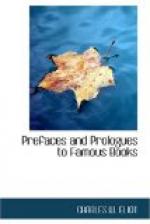Let there be no misunderstanding: if some of our poets have succeeded in being great, even when copying, it is because, while forming themselves on the antique model, they have often listened to the voice of nature and to their own genius—it is because they have been themselves in some one respect. Their branches became entangled in those of the near-by tree, but their roots were buried deep in the soil of art. They were the ivy, not the mistletoe. Then came imitators of the second rank, who, having neither roots in the earth, nor genius in their souls, had to confine themselves to imitation. As Charles Nodier says: “After the school of Athens, the school of Alexandria.” Then there was a deluge of mediocrity; then there came a swarm of those treatises on poetry, so annoying to true talent, so convenient for mediocrity. We were told that everything was done, and God was forbidden to create more Molieres or Corneilles. Memory was put in place of imagination. Imagination itself was subjected to hard-and-fast rules, and aphorisms were made about it: “To imagine,” says La Harpe, with his naive assurance, “is in substance to remember, that is all.”
But nature! Nature and truth!—And here, in order to prove that, far from demolishing art, the new ideas aim only to reconstruct it more firmly and on a better foundation, let us try to point out the impassable limit which in our opinion, separates reality according to art from reality according to nature. It is careless to confuse them as some ill-informed partisans of romanticism do. Truth in art cannot possibly be, as several writers have claimed, absolute reality. Art cannot produce the thing itself. Let us imagine, for example, one of those unreflecting promoters of absolute nature, of nature viewed apart from art, at the performance of a romantic play, say Le Cid. “What’s that?” he will ask at the first word. “The Cid speaks in verse? It isn’t natural to speak in verse.”—“How would you have him speak, pray?”—“In prose.” Very good. A moment later, “How’s this!” he will continue, if he is consistent; “the Cid is speaking French!”—“Well?”—“Nature demands that he speak his own language; he can’t speak anything but Spanish.”




